Silent Hill: Origins Review
Silent Hill: Origins
Origins looks and feels like a classic Silent Hill game, but is that a good thing?
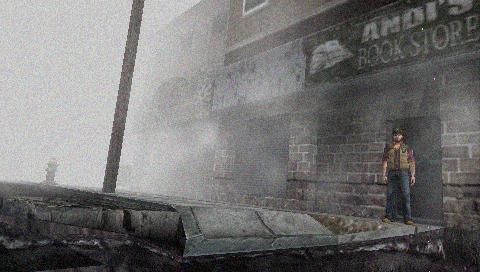
Verdict
Key Specifications
- Review Price: £23.35
Barring last year’s Christophe Gans movie adaptation, fans of the Silent Hill series haven’t had much to celebrate in the four years since Silent Hill 3. The last game in the series, Silent Hill 4: The Room was clearly a separate game hastily integrated into the Silent Hill mythos. Meanwhile a brand that – for a while – sat at the pinnacle of the Survival Horror genre has seen itself overtaken by a revitalised Resident Evil, the increasingly potent Project Zero series and even Sony’s under-rated (if overcomplicated) Forbidden Siren duo. So the news that the first proper entry in ages, Silent Hill: Origins, was to come from a new developer and on a handheld format must have been met with an agonizing mix of hope and misery. After all, PSP reworkings of existing franchises haven’t always met the highest quality standards, and there’s always a huge risk in handing a Japanese property over to a Western developer. That goes double when the series’ ‘feel’ is so important.
So the good news is that UK developer Climax’s take on the world of Silent Hill stays very true to Team Silent’s existing work. Visually, Origins sits as close to what we saw in Silent Hill 2 and 3 as you could reasonably expect on the PSP. Gaming’s most mysterious town remains wreathed in an almost tangible gloom and swathed in thick layers of floating fog. The sense of decay is palpable. Lighting is minimal and expertly used, and the glare of your character’s torchlight is handled brilliantly. Origins also manages the gritty film overlay that has been a signature of the series since Silent Hill 2, and even enhances it with a range of cool film-jumping and scratch effects. The environments have just about the right level of clutter and mess, and apart from the slightly boxy-looking character models, Climax has the Silent Hill 2/3 look nailed.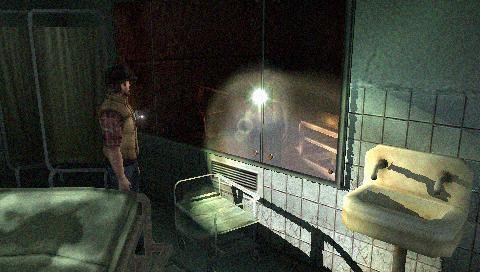
More impressively, Climax has also captured the right tone. This time our hero is burly trucker Travis Grady, and his journey through Silent Hill takes him through events connected to the first game – making Origins a sort of prequel – with twists that seem to parallel the second. Those of us who played the first game can reacquaint ourselves with scary Dahlia Gillespie, her creepy daughter, Alessa, and unhinged nurse, Lisa, not to mention such locations as the good old Alchemilla Hospital. Those of us who loved the second will be thrilled to see an antagonist so reminiscent of the series’ most terrifying monster, Pyramid Head, and moments that mirror key portions of Silent Hill 2. If you know Silent Hill 1 to 3, then you’ll find Origins brings the series full-circle and carefully pulls a few loose ends together. If not, don’t worry. Silent Hill is always an interior journey for its lead as well, and this one takes Travis back into the unexplored dark regions of his own past. New locations like the Cedar Grove Sanatorium, the Butcher’s Shop and the Artaud Theatre fit in perfectly with the seedy Silent Hill ambiance, and the storyline develops with that mix of strange mystery and psychological turmoil that is the hallmark of the series.
Atmospherically it’s horribly effective, particularly if, as the game suggests, you play it with your headphones on and the lights turned down. The headphones are particularly important, because it’s the audio – the crackle of the ‘monster alert’ radio, the hiss or grunt of something moving close by but just out of sight – that makes the game so damn scary. The music, by series stalwart Akira Yamaoka, is packed with foreboding ambient tracks that escalate suddenly into peaks of churning menace, and is arguably the most unsettling thing about the whole game. Meanwhile, the constant drip-feed of information through reports, notes and odd, childish drawings is more unnerving than all of the shock scares and crimson gore in Clive Barker’s Jericho. If Silent Hill is all about lurking fear and creeping dread, then Origins is a Silent Hill game through and through.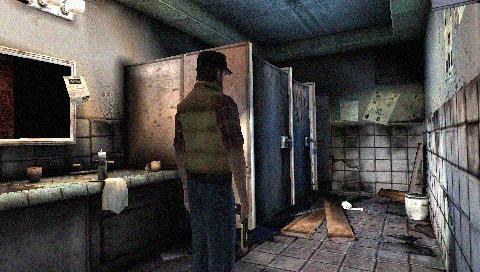
Most importantly, Origins has preserved the series’ defining characteristic: its splitting of Silent Hill into a warped, fog-bound normal world and a rusty, industrial-looking netherworld, both peopled by hideous apparitions, both linked by common pathways and architecture, but differing in small ways you can exploit throughout the game. Origins cunningly makes the netherworld a sort of dark reflection, and allows you to travel between the two sides to use new pathways or open new doorways just by touching any nearby mirror. You could argue that putting the player in control loses a little of the old terror of suddenly finding yourself in Silent Hill’s version of hell – and you wouldn’t be wrong – but it allows for a few ingenious puzzles and a little less backtracking in complex areas like the Sanatorium. And as with any Silent Hill, there’s an argument that the two worlds reflect different states of your protagonist’s mind: one a twisted vision of his present-day reality, the other a nightmare representation of his repressed unconscious. Fans will realise that this is exactly what makes the series so special: did Resident Evil ever encourage as much pretentious, pseudo psycho-analytic tosh as that?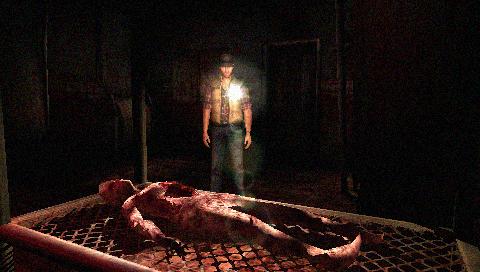
But if presenting the authentic Silent Hill experience is Origin’s triumph, it’s also its downfall. The fact is that the Survival Horror genre has moved on since Silent Hill 3, and a lot of the old Silent Hill conventions – so faithfully reproduced here – now feel horribly dated. The third-person movement is slow, unwieldy and occasionally counter-intuitive. The reliance on fixed camera angles, even with a one-click reposition button, means that you can’t always see the monster bearing down on you until it’s far too late. Puzzles aren’t quite as ridiculously cryptic as they were in Silent Hill 1 and 2, but there are still a couple of real humdingers. Worst of all, the combat is pretty much awful.
Let me explain. The streets, rooms and corridors of Silent Hill are crawling with grisly, flayed-looking monsters, disfigured nurse-like creatures and lumbering beasts. You slowly gather a small selection of ranged weapons, but as ammo is scarce you’re best saving these for key boss battles. Doing so means that for the majority of the game you’re restricted to melee weapons, pressing the right shoulder button to lock on and then bashing X to take a swipe. Unfortunately, most of the creatures need to be whacked repeatedly before they go down, and even then they will get up several times before they have the good grace to lie still. 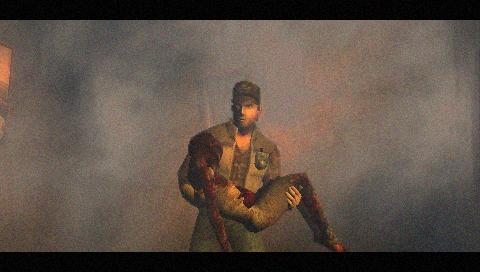
Three things make this even more annoying. First, melee weapons only last for a limited number of hits before suddenly breaking or dissolving, requiring you to rapidly switch to another weapon in mid-smackdown. Secondly, creatures frequently attack en masse, and dealing with more than one at a time is a nightmare unless they’re kind enough to line up neatly in front of your swinging wrench or 2×4 plank. Thirdly, creatures in some areas seem to respawn or get periodically replaced, which makes beating them down utterly pointless.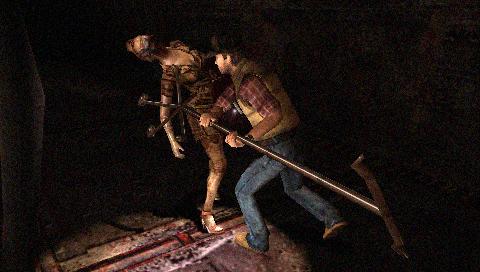
As a result, you soon learn to avoid combat altogether. It appears that the poor photo-sensitive denizens of Silent Hill are alerted by the shine of your flashlight, so you realise that one of Silent Hill’s signature features is actually best switched off. Having done so, you spend most of your time comically sprinting past every last ghoul and revenant in order to get to your next objective without having to waste time fighting them. This isn’t a new thing to Silent Hill by any means, but where once the idea of fleeing from demons seemed a part of the whole scary experience, you now feel more like you’re just avoiding a source of prolonged hassle. On an emotional level, it’s less the stuff of nightmares than the stuff of avoiding clipboard-carrying charity workers on your way down the high street. And isn’t it slightly ridiculous that you end up – apparently – with a coat bulging full of portable televisions, jumbo bottles of alcohol, metal drip-hangers, cleavers, meat-hooks and sledgehammers just because you can never have too many highly breakable melee weapons in such a monster infested town?
To make things worse, the game still relies heavily on long corridors with mostly locked doors, long stretches where you have to go from the east wing to pick up object X and then travel to the west wing to use it, and it still hasn’t learnt to place save points sensibly or add checkpoints where they might be useful. I agree that saving anywhere kills this sort of game, but would it really kill to add a quick restart point when you enter a new building or before you start a potentially fatal encounter? I spent large portions of the game backtracking to use an old save point just because I couldn’t risk waiting to find a new one. This doesn’t help you immerse yourself in the game world – it’s the sort of thing that constantly drags you out of it.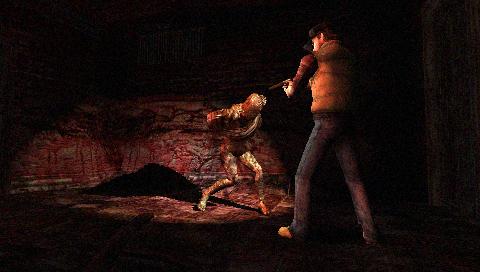
In short, we’re left with a bit of a dilemma. On the one hand, the game gets the authentic Silent Hill atmosphere so right. At its best it is an unnerving experience and occasionally deeply scary. There’s also something undeniably addictive about the whole process of piecing together the fragments of the past and finding the next stage in the story. The game length – around six or seven hours – is a worry, but it’s one I’m willing to overlook because there really isn’t anything else out there like this on the PSP, or indeed any other handheld console. Technically, too, Origins is an accomplished title, with some of the best graphics and shortest load times on the system. 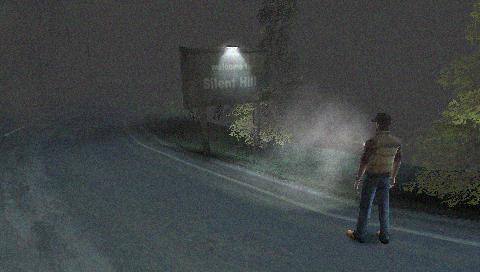
But on the other hand, this still isn’t the must-have PSP game it could have been. It’s too clunky, too irritating and too old-school for that. It feels like Climax has held onto the Silent Hill baby, but left it floating in that dirty old Silent Hill bathwater. In a way, I’m hoping that Silent Hill: Origins is a capstone to the old-school Silent Hill, and that it sets the stage for a Silent Hill V that can retain the series’ atmosphere but do away with its dated mechanics – an opportunity Origins has missed.
”’Verdict”’
The atmosphere is chilling, but it’s the game mechanics, not the floorboards, that are creaking. A terrifying treat for the Silent Hill fanbase, but a slight disappointment for anyone hoping for a Grade A PSP title.

